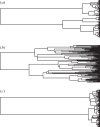Losing history: how extinctions prune features from the tree of life
- PMID: 25561667
- PMCID: PMC4290420
- DOI: 10.1098/rstb.2014.0006
Losing history: how extinctions prune features from the tree of life
Abstract
Biodiversity provides many valuable services to humanity; however, rapid expansion of the human population has placed increasing pressure on natural systems, and it has been suggested that we may be entering a sixth mass extinction. There is an urgent need, therefore, to prioritize conservation efforts if we are to maintain the provisioning of such service in the future. Phylogenetic diversity (PD), the summed branch lengths that connect species on the tree-of-life, might provide a valuable metric for conservation prioritization because it has been argued to capture feature diversity. Frequently, PD is estimated in millions of years, and therefore implicitly assumes an evolutionary model in which features diverge gradually over time. Here, I explore the expected loss of feature diversity when this assumption is violated. If evolution tends to slow down over time, as might be the case following adaptive radiations, losses of feature diversity might be relatively small. However, if evolution occurs in rapid bursts, following a punctuated model, impacts of extinctions might be much greater. PD captures many important properties, but if we use it as a proxy for feature diversity, we first need to ensure that we have the correct evolutionary model.
Keywords: ecosystem services; feature diversity; phylogenetic diversity; phylogeny; punctuated evolution.
© 2015 The Author(s) Published by the Royal Society. All rights reserved.
Figures



Similar articles
-
Predicting loss of evolutionary history: Where are we?Biol Rev Camb Philos Soc. 2017 Feb;92(1):271-291. doi: 10.1111/brv.12228. Epub 2015 Oct 14. Biol Rev Camb Philos Soc. 2017. PMID: 26467982 Review.
-
Phylogenetic diversity, functional trait diversity and extinction: avoiding tipping points and worst-case losses.Philos Trans R Soc Lond B Biol Sci. 2015 Feb 19;370(1662):20140011. doi: 10.1098/rstb.2014.0011. Philos Trans R Soc Lond B Biol Sci. 2015. PMID: 25561672 Free PMC article.
-
Revisiting the impacts of non-random extinction on the tree-of-life.Biol Lett. 2013 Jun 12;9(4):20130343. doi: 10.1098/rsbl.2013.0343. Print 2013 Aug 23. Biol Lett. 2013. PMID: 23760169 Free PMC article.
-
Threatened species and the potential loss of phylogenetic diversity: conservation scenarios based on estimated extinction probabilities and phylogenetic risk analysis.Conserv Biol. 2008 Dec;22(6):1461-70. doi: 10.1111/j.1523-1739.2008.01068.x. Epub 2008 Sep 15. Conserv Biol. 2008. PMID: 18798854
-
Biodiversity and evolutionary history: useful extensions of the PD phylogenetic diversity assessment framework.Ann N Y Acad Sci. 2013 Jun;1289:69-89. doi: 10.1111/nyas.12186. Ann N Y Acad Sci. 2013. PMID: 23773093 Review.
Cited by
-
Integrating biogeography, threat and evolutionary data to explore extinction crisis in the taxonomic group of cycads.Ecol Evol. 2017 Mar 21;7(8):2735-2746. doi: 10.1002/ece3.2660. eCollection 2017 Apr. Ecol Evol. 2017. PMID: 28428864 Free PMC article.
-
Heterochrony as Diachronically Modified Cell-Cell Interactions.Biology (Basel). 2016 Jan 14;5(1):4. doi: 10.3390/biology5010004. Biology (Basel). 2016. PMID: 26784244 Free PMC article.
-
The decline of mammal functional and evolutionary diversity worldwide.Proc Natl Acad Sci U S A. 2021 Jan 19;118(3):e1921849118. doi: 10.1073/pnas.1921849118. Proc Natl Acad Sci U S A. 2021. PMID: 33397807 Free PMC article.
-
Phylogeny, extinction and conservation: embracing uncertainties in a time of urgency.Philos Trans R Soc Lond B Biol Sci. 2015 Feb 19;370(1662):20140002. doi: 10.1098/rstb.2014.0002. Philos Trans R Soc Lond B Biol Sci. 2015. PMID: 25561663 Free PMC article.
References
-
- Millennium Ecosystem Assessment. 2005. Ecosystems and human well-being: synthesis. Washington, DC: Island Press.
MeSH terms
LinkOut - more resources
Full Text Sources
Other Literature Sources

